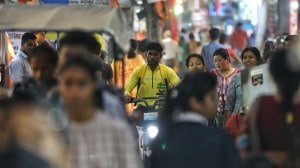- India
- International
What is coronavirus pandemic?
Coronavirus Pandemic, Covid-19 Symptoms, Precautions, Vaccine, Medicine, Cases in India and World: Here's how the novel coronavirus pandemic started and a summary of the biggest developments in the novel coronavirus outbreak.
 Coronavirus (Covid-19) cases, symptoms, precautions: The United States is at the top of the list in coronavirus infections and deaths that stand at 1,256,972 and 75,670 respectively.
Coronavirus (Covid-19) cases, symptoms, precautions: The United States is at the top of the list in coronavirus infections and deaths that stand at 1,256,972 and 75,670 respectively.
Coronavirus (Covid-19) cases, symptoms, precautions: For the last few months, the world has been consumed with a minute virus — roughly 65–125 nanometres in diameter — that has been infecting and killing the human population. It first came to light on December 31, 2019 when China reported to the World Health Organization (WHO) a string of pneumonia-like cases in Wuhan, the capital of Hubei province.
Covid-19 as it came to be known later, spread fast across the global from Wuhan affecting people without distinction. It created a united international effort to not only track and contain the virus, but also develop a cure or vaccine.
Many countries went into lockdown, placing restrictions on the movement of people and barring international visitors to blunt the spread of the virus and prevent community transmission.
The United States believes China is to be held responsible for failing to tame the virus at its origin as 184 countries are now “going through hell”. China, on its part, is stonewalling any international inquiry, and asserts that the origin of the virus was a matter of science and should be studied by scientists and professionals.
How the novel coronavirus went from epidemic to global pandemic
China’s mystery virus that triggered worry: A top Chinese scientist had confirmed earlier this year that the mysterious coronavirus (a type of virus named after its spiky, solar corona-like appearance under an electron microscope) can spread between human beings. Chinese authorities had earlier said the virus was transmitted only from animals to humans. “Now we can say it is certain that it is a human-to-human transmission phenomenon,” Zhong Nanshan, the scientist leading China’s government-appointed expert panel, said.

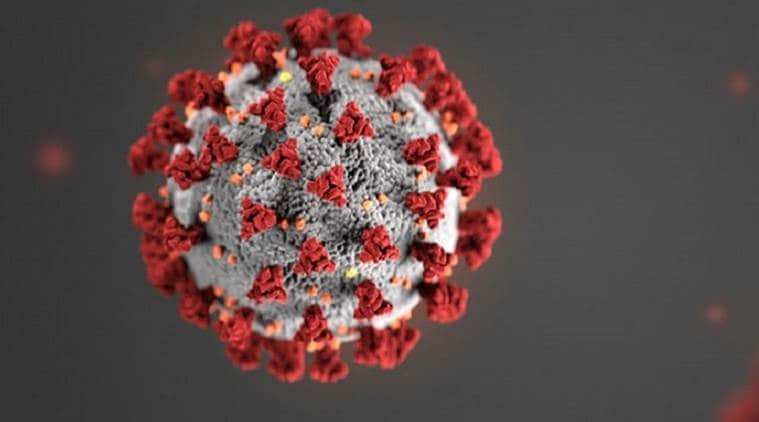 An illustration of the coronavirus, a type of virus named after its spiky, solar corona-like appearance under an electron microscope.
An illustration of the coronavirus, a type of virus named after its spiky, solar corona-like appearance under an electron microscope.
WHO races to declare coronavirus a pandemic: Soon after it was clear that the coronavirus was spreading fast in China, and had infected may others across the world, the WHO rushed to declare coronavirus as a pandemic. Some countries, however, said the global health body was late in declaring coronavirus a pandemic and received its share of criticism.
Novel coronavirus to be called Covid-19: Subsequently, the WHO gave an official name to the disease caused by the novel coronavirus. The disease will be called “COVID-19”; the “CO” stands for coronavirus, “VI” for virus and “D” for disease. The coronavirus itself is called “nCoV-2019”.
Why bats carry viruses but don’t fall ill themselves: As the world tries to better understand how does coronavirus spread among humans, studies were underway to better understand its origin and how it is transmitted. Diseases caused by coronaviruses, such as Covid-19, are zoonotic, meaning they are transmitted between animals and people. According to the World Health Organisation (WHO), SARS-CoV was transmitted to humans from civet cats, and MERS-CoV from dromedary camels. Both the viruses, however, are believed to have originated from bats and subsequently passed on to other animals. While researchers are yet to conclude how the novel coronavirus, which was first detected in China’s Wuhan, originated, many believe it could be traced back to bats.
 Health officials inspect bats to be confiscated and culled in the wake of coronavirus outbreak at a live animal market in Solo, Central Java, Indonesia. (AP Photo)
Health officials inspect bats to be confiscated and culled in the wake of coronavirus outbreak at a live animal market in Solo, Central Java, Indonesia. (AP Photo)
European countries implement a lockdown: Similarly, European nations, as well as the rest of the world, began evacuating its nationals stranded in various countries. And soon, many countries imposed lockdowns to contain Covid-19. Among all continents, Europe has seen the most number of deaths due to the novel coronavirus, and many countries here have significantly clamped down on public life to combat the outbreak.
But not all countries have imposed lockdown: Amid the coronavirus outbreak, countries across the world have relied on complete or partial lockdowns as a mitigative step to control the spread of infection. But then there were other countries, such as Sweden, and South Korea, that hadn’t imposed lockdowns despite surging global death toll.
How some Pacific nations have held off COVID-19, but are still at risk: While many countries had been affected by the pandemic, there were still some island countries in the Pacific Ocean where the pandemic was yet to hit. As of April 2, Comoros, Kiribati, Marshall Islands, Micronesia, Nauru, Palau, Samoa, Sao Tome and Principe, Solomon Islands, Tonga, Tuvalu and Vanuatu had not reported any Covid-19 cases.
Lockdown in several countries, in some cases, didn’t prevent civilians from protesting against government policies on a wide range of issues, ranging from inequality to hunger and unemployment, all of which have intensified following the global outbreak of the coronavirus infection. Following the detection of Covid-19 in their territories, several nations around the world have placed curbs on large gatherings of people. Lebanese people, for example, took to the streets after the country imposed a state of emergency to combat the spread of coronavirus, closing land and sea ports. Many citizens expressed concerns that these moves would cause further setback to an already beleaguered country.
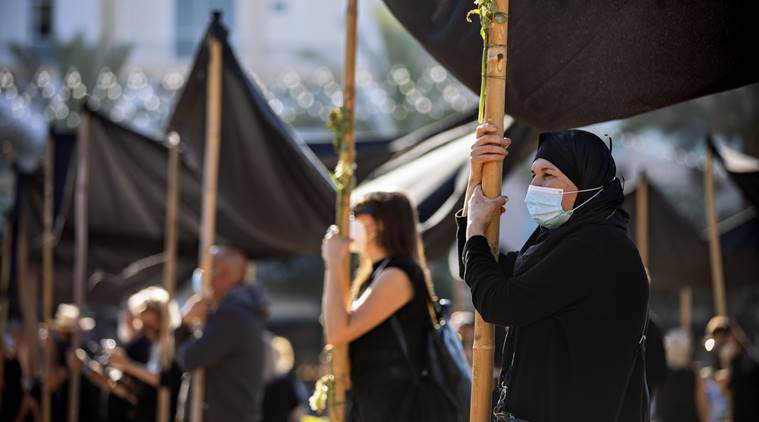 Wedding producers wear protective face masks amid concerns over the country’s coronavirus outbreak, as they hold black canopies during a protest against the government over its handling of the pandemic and the economic fallout, in Tel Aviv, Israel, Thursday, May 7, 2020. In the last two months all weddings and and public events were canceled following the government’s measures to help stop the spread of the virus. (AP Photo: Oded Balilty)
Wedding producers wear protective face masks amid concerns over the country’s coronavirus outbreak, as they hold black canopies during a protest against the government over its handling of the pandemic and the economic fallout, in Tel Aviv, Israel, Thursday, May 7, 2020. In the last two months all weddings and and public events were canceled following the government’s measures to help stop the spread of the virus. (AP Photo: Oded Balilty)
Extended lockdowns came with its own fallout though, especially on the mental health of people. There were reports of a global surge in domestic violence cases too prompting the UN Secretary-General António Guterres to appeal governments to pay attention to and prevent the occurrence. The Council of Europe, an intergovernmental human rights agency comprising 47 member states, also expressed concern about the increase in domestic violence during lockdowns due to the coronavirus, and said women and children were at greater risk of abuse within their own homes during this period.
Amid all of this, one of the silver linings that has been reported from across the world is that people are breathing cleaner air and are witness to clearer, more blue skies as human movement has been restricted due to lockdowns imposed by various countries. But it also complicates the conversation around climate change and nations rush to first deal with the crisis at hand and overlook climate concerns in the short term.
 People wearing face visors rest in a public garden just hours before the start of a two-day curfew declared by the government in an attempt to control the spread of coronavirus, in Ankara, Turkey, Friday, May 8, 2020. (AP Photo: Burhan Ozbilici)
People wearing face visors rest in a public garden just hours before the start of a two-day curfew declared by the government in an attempt to control the spread of coronavirus, in Ankara, Turkey, Friday, May 8, 2020. (AP Photo: Burhan Ozbilici)
Economists comparing current crisis with Great Depression: What was it?
But the more immediate impact of the coronavirus was on the global economy as businesses and industries across the world came to a grinding halt. The economy took a big hit with some experts comparing the current crisis with the Great Depression — the devastating economic decline of the 1930s that went on to shape countless world events. Experts warned that unemployment levels in some countries could reach those from the 1930s era, when the unemployment rate was as high as around 25 per cent in the United States.
So, what could be the cost that the global economy will likely pay in view of the coronavirus? While it may be difficult to arrive at an agreed upon number for the cost of the outbreak — given the issues around a “statistical value of human life” and the uncertainty associated with viral diseases — the mildest global pandemic can be expected to wipe out at least 1% of the world’s GDP, experts say.
In the past month, there have been reports of recovered Covid-19 patients testing positive a second time. Since the exact behaviour of the novel coronavirus is still being studied, immunity against it is not fully understood. For instance, previous coronavirus outbreaks have been inconsistent: a study on the coronavirus that caused MERS revealed that patients are unlikely to get re-infected within a short duration of the original infection; but, after the SARS outbreak, cases of relapse that were reported. Theoretically, various factors can cause relapse in patients recovered from Covid-19. SARS-CoV-2, the virus that causes Covid-19, is like viruses that cause any other flu. Therefore, there is always a probability of mutation as in the case of influenza viruses. The mutation, theoretically, can make an individual vulnerable to reacquire the COVID-19 infection.
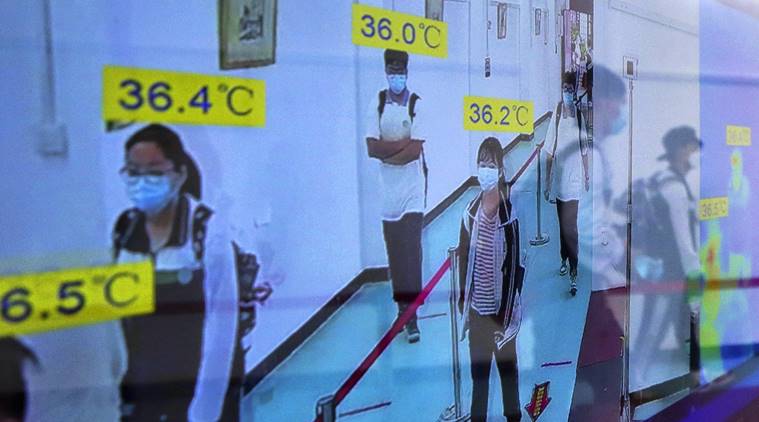 Students wearing face masks are reflected on a monitor screen showing their body temperatures as they arrive to a high school in Wuhan in central China’s Hubei province, Wednesday, May 6, 2020. Is this the new normal? (Chinatopix via AP)
Students wearing face masks are reflected on a monitor screen showing their body temperatures as they arrive to a high school in Wuhan in central China’s Hubei province, Wednesday, May 6, 2020. Is this the new normal? (Chinatopix via AP)
Are men more prone to Covid-19 deaths?
That men seem likelier than women to die of the novel coronavirus disease was reported early on in the outbreak — and a paper by Chinese researchers published in mid-February analysed data from Wuhan, Hubei, and China as a whole to calculate a fatality rate of 2.8% for men, as compared to 1.7% for women. In subsequent weeks, as the footprint of the disease covered the entire planet, the same pattern was detected in almost all countries that released sex-aggregated data — including Italy, Iran, South Korea, Germany, and France. Most recently, data from the national statistics office of the United Kingdom — where over 13,700 people had died by Thursday evening — showed that men were twice as likely as women to die from COVID-19. India does not provide consolidated sex-aggregated data on fatalities. The question is, why? The short answer: researchers don’t yet know for sure. But several hypotheses have been articulated.
How does the coronavirus attack?
In the search for a treatment for COVID-19 disease, researchers have been targeting specific behaviours of the novel coronavirus (SARS-CoV2) that causes the disease. While the virus itself is still being studied, the hunt for a treatment is based on what is known so far about the way it infects humans.
So, what are the various stages of a pandemic, you may ask? In the first stage of a disease epidemic that eventually takes the form of a pandemic sweeping the globe, cases are imported into a country in which the infection did not originate. An infection whose spread is contained within the boundaries of one or a few countries is obviously not a pandemic. The second stage is when the virus starts being transmitted locally. Local transmission means that the source of the infection is from within a particular area and the trajectory the virus has taken from one person to the next is clearly established. The third stage is that of community transmission. In layman terms, it means that the virus is now circulating in the community, and can infect people with no history either of travel to affected areas or of contact with an infected person.
📢 Express Explained is now on Telegram. Click here to join our channel (@ieexplained) and stay updated with the latest
So how can you take care of yourself during the Covid-19 pandemic?
It is not necessary that a Covid-19 patient will always infect everyone who came close to them. Second, to know if they did, the newly infected has to develop symptoms, which not everyone does. But if one does begin to feel unwell, the Health Ministry advises self-isolation by staying at home. Do that even with mild symptoms such as headache, low-grade fever and slight runny nose, until you recover.
With surgical and N95 masks in short supply, the Indian Health Ministry recently published an advisory on how you can make your own face cover at home. For material, the Indian advisory recommends cotton, while the US Centers for Disease Control and Prevention recommend “cloth face coverings” without specifying the fabric. Now, a study has examined the ability of various materials to keep out respiratory particles — and by extension the novel coronavirus — and identified a combination of two fabrics as possibly the best: either cotton plus natural silk, or cotton plus chiffon.
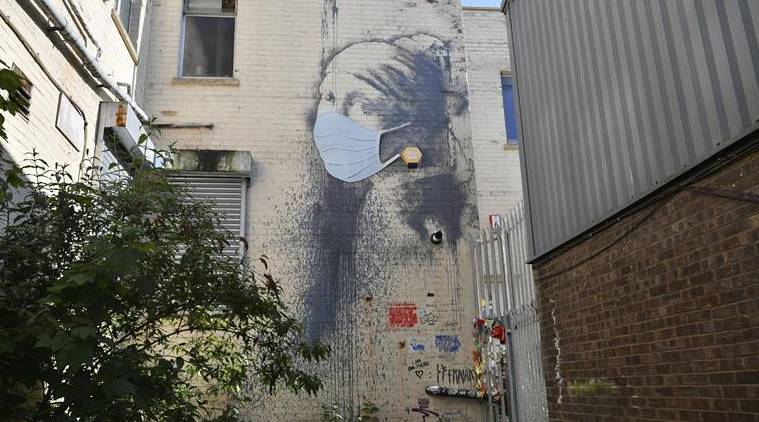 England-based street artist Banksy’s work The Girl With The Pierced Eardrum — inspired by Johannes Vermeer’s painting The Girl With The Pearl Earring — get a makeover amid the Covid-19 pandemic. It now appears with a mask in Bristol’s Albion Docks. (Ben Birchall/PA via AP)
England-based street artist Banksy’s work The Girl With The Pierced Eardrum — inspired by Johannes Vermeer’s painting The Girl With The Pearl Earring — get a makeover amid the Covid-19 pandemic. It now appears with a mask in Bristol’s Albion Docks. (Ben Birchall/PA via AP)
Covid-19 vaccines: The question is when?
A recent announcement by the University of Oxford that researchers there had started testing a vaccine against the novel coronavirus disease (Covid-19) has raised hopes. Over the last few weeks, there have also been somewhat conflicting reports about the performance of a drug candidate, remdesivir, while Israel has announced a breakthrough in another possible line of treatment, that with antibodies.
Meanwhile, there was chatter over whether the age-old BCG vaccine could also protect against the novel coronavirus (SARS-CoV2)? That is a question the scientific community worldwide has been discussing over the past few days, ever since a study pending peer review made the claim, and another set of researchers then refuted it.
 An ampule of Ebola drug Remdesivir is pictured. (Ulrich Perrey/Pool via Reuters)
An ampule of Ebola drug Remdesivir is pictured. (Ulrich Perrey/Pool via Reuters)
Then, spotlight falls on Remdesivir as a possible treatment for critical cases of novel coronavirus disease (COVID-19). Globally, it is one of the four possible lines of treatment being investigated in the Solidarity trials under the aegis of the World Health Organization (WHO). While the drug is yet to get approval in any country to treat COVID-19, recent studies have claimed they have found promising results.
But no drug has been discussed more in the context of Covid-19 than hydroxychloroquine. In India, the government announced that it is to be administered it to very specific groups, such as healthcare workers exposed to COVID-19 patients. The drug, that has existed for several decades, has been recommended for prophylaxis in case of asymptomatic healthcare workers involved in the care of suspected or confirmed cases of COVID-19 and asymptomatic household contacts of laboratory confirmed cases. US President Donald Trump too applied pressure on India to send supplies of the drug he has been touting as the cure.
Meanwhile, many people have volunteered to take part in a controversial testing method called human challenge trials. As of April 27, a global initiative called 1DaySooner had registered 3,817 people in 52 countries who had signed up for such trials. The method, which involves intentionally infecting volunteers with the novel coronavirus, is being promoted in order to “speed up” the process of preparing a vaccine.
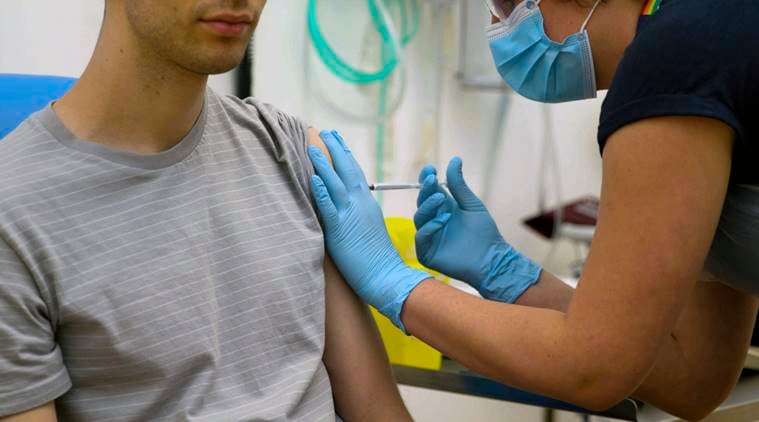 A volunteer is injected with either an experimental Covid-19 vaccine or a comparison shot as part of the first human trials in the UK to test a potential vaccine, led by Oxford University in England on April 25, 2020. (University of Oxford via AP)
A volunteer is injected with either an experimental Covid-19 vaccine or a comparison shot as part of the first human trials in the UK to test a potential vaccine, led by Oxford University in England on April 25, 2020. (University of Oxford via AP)
As lockdowns are being relaxed world over, with no relief in sight yet, the big question is: After the pandemic wave, what will happen to the coronavirus?
As coronavirus cases continue to surge across the world and millions are confined to their homes, governments are still thinking about how and when lockdowns can be lifted so that normalcy can resume. With a vaccine at least 12-18 months away, scientists and researchers are now looking into what the post pandemic transmission of SARS-CoV-2 can look like and the possible measures that might be needed to control future outbreaks. A new study published in Science looks at what will happen after the initial, most severe pandemic wave passes.
More Explained
EXPRESS OPINION
Apr 20: Latest News
- 01
- 02
- 03
- 04
- 05





















